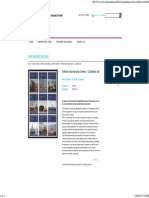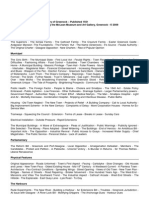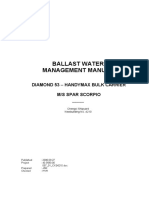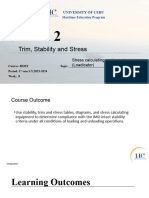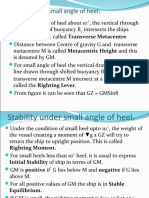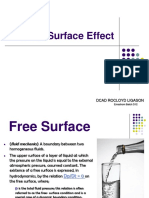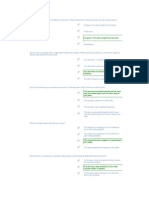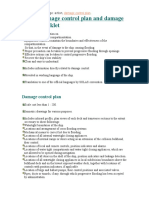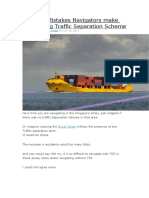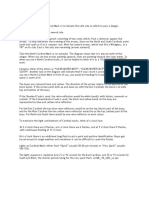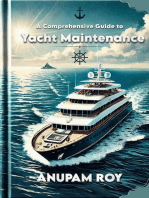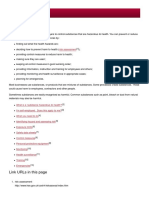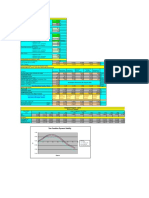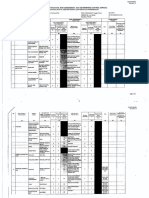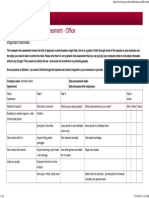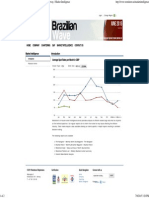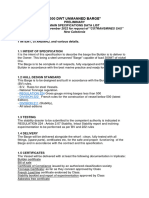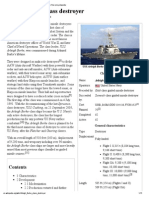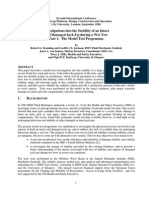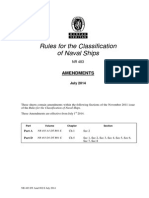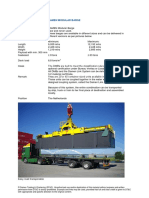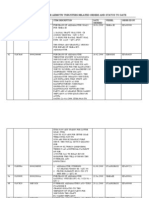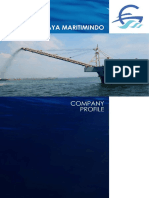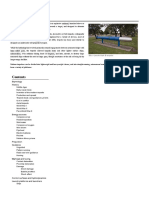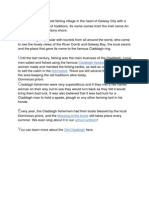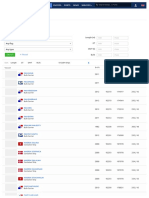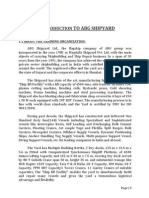Ship Squat
Ship Squat
Uploaded by
Wisnu KertaningnagoroCopyright:
Available Formats
Ship Squat
Ship Squat
Uploaded by
Wisnu KertaningnagoroOriginal Description:
Copyright
Available Formats
Share this document
Did you find this document useful?
Is this content inappropriate?
Copyright:
Available Formats
Ship Squat
Ship Squat
Uploaded by
Wisnu KertaningnagoroCopyright:
Available Formats
Ship-Squat.com Home > How do I predict Ship Squat?
1 of 2
http://www.ship-squat.com/How_do_I_predict_Ship_Squat.htm
You are here: Ship-Squat.com Home > How do I predict Ship Squat?
Ship-Squat Home
What are the factors governing Ship Squat?
About Bryan Barrass
The main factor is ship speed Vk. Squat varies approximately with the speed squared. As an
example, if we double the speed we quadruple the squat. Put another way, it can be shown
that halving the ships speed will quarter the squat. In this context, speed Vk is the ships
speed relative to the water so the effect of current/tide speed with or against the ship must be
taken into account.
Consultancy and training
Research papers
Frequently Asked Questions
Another important factor is the block coefficient Cb. Squat varies directly with Cb. Oil Tankers
will therefore have comparatively more squat than Passenger Liners.
S A Malliaroudakis Maritime Ltd
What is Ship Squat?
Why predict Ship Squat?
The Blockage Factor 'S' is another factor to consider. This is the immersed cross-section of the
ships midship section divided by the cross-section of water within the canal or river. If the ship
is in open water the width of influence of water can be calculated. This ranges from about
8.25b for Supertankers, to about 9.50b for General Cargo ships, to about 11.25 ship-breadths
for Container Ships.
Groundings due to Ship Squat
How do I predict Ship Squat?
Tables and curves (MS Excel)
Shallow water signs
Contact
The presence of another ship in a narrow river will also affect squat, so much so, that squats
can double in value as they pass or cross the other vessel.
Formulae have been developed that will be satisfactory for estimating maximum ships squats
for vessels operating in confined channels and in open water conditions.
These formulae are have been derived from analysing about 600 results. some measured on
ships and some on ship-models. Some of the empirical formulae developed are as follows:
Let b = Breadth of ship.
Let H = Depth of water.
Let Cb = Block co-efficient.
Let B = Breadth of river or canal.
Let T = Ships even keel static draft.
Let Vk = Ship speed relative to the water in knots.
Let CSA = Cross Sectional Area.
Let S = Blockage factor = CSA of ship / CSA of river or canal.
K1, K2 and K3 are squat coefficients.
If ship is in open water conditions, then the formula for B becomes:
B = (7.04/Cb^0.85) ship breadths. This is known as the width of influence.
Blockage factor = S = (b x T) / (B x H).
Maximum Squat = (Cb x S^0.81 x Vk^2.08) / K1 metres for open water and confined channels.
Two short-cut formulae relative to the previous equation are:
9/18/2014 10:50 AM
Ship-Squat.com Home > How do I predict Ship Squat?
2 of 2
http://www.ship-squat.com/How_do_I_predict_Ship_Squat.htm
Maximum squat = (Cb x Vk^2) / K2 metres for open water conditions only, with H / T 1.1 to 1.4.
Maximum squat = (Cb x Vk^2) / K3 metres for confined channels,
where S = 0.100 to 0.250.
Back to top
9/18/2014 10:50 AM
You might also like
- Oilfield Seamanship Series - Complete SetDocument2 pagesOilfield Seamanship Series - Complete SetWisnu Kertaningnagoro0% (1)
- Hunt For Red October OCRDocument31 pagesHunt For Red October OCRJames Jenkins100% (2)
- Volume Chain Locker GL ClassDocument1 pageVolume Chain Locker GL ClassWisnu KertaningnagoroNo ratings yet
- Code of Safe Working Practices for Merchant Seafarers: Consolidated edition (incorporating amendments 1-6)From EverandCode of Safe Working Practices for Merchant Seafarers: Consolidated edition (incorporating amendments 1-6)No ratings yet
- Test Stabillity 1 2009Document6 pagesTest Stabillity 1 2009Yuriy Kakaranze0% (1)
- Shipboard High Voltage Application and Safeties - Hanif Dewan's BlogDocument26 pagesShipboard High Voltage Application and Safeties - Hanif Dewan's BlogWisnu Kertaningnagoro100% (1)
- Vegetable Oils and Fats On Chemical Tankers - Capt Ajit VadakayilDocument29 pagesVegetable Oils and Fats On Chemical Tankers - Capt Ajit VadakayilWisnu KertaningnagoroNo ratings yet
- Enclosed Space Drill ScenarioDocument1 pageEnclosed Space Drill ScenarioWisnu Kertaningnagoro100% (1)
- Example COSHH Risk Assessment - Workshop - COSHHDocument2 pagesExample COSHH Risk Assessment - Workshop - COSHHWisnu KertaningnagoroNo ratings yet
- History Greenock 1921Document179 pagesHistory Greenock 1921mairi210% (2)
- Ship Stability NomenclatureDocument6 pagesShip Stability NomenclatureRoderick EstrellaNo ratings yet
- Ballast Water Management ManualDocument226 pagesBallast Water Management ManualAnonymous ycFeyuLAtNo ratings yet
- Ship To Ship InteractionDocument15 pagesShip To Ship InteractionGlen MacNo ratings yet
- Ship Stability: Damaged Stability of ShipsDocument11 pagesShip Stability: Damaged Stability of ShipsgeorgesagunaNo ratings yet
- Ship DynamicsDocument82 pagesShip Dynamicsthenavaler100% (2)
- The Nautical Institute - Interaction ManoueveringDocument22 pagesThe Nautical Institute - Interaction ManoueveringClaudio MF100% (1)
- Ship Stability & Draft SurveyDocument33 pagesShip Stability & Draft SurveyAnanda Amalina100% (2)
- Parametric RollingDocument7 pagesParametric RollingneerajNo ratings yet
- Container Cargo NotesDocument8 pagesContainer Cargo NotesdhaneshbhorNo ratings yet
- 4.1 Passenger Ship Subdivision - 1-6pgDocument6 pages4.1 Passenger Ship Subdivision - 1-6pgoussama achouriNo ratings yet
- Seam 2 Week 8 Stress Calculating Equipment LoadicatorDocument36 pagesSeam 2 Week 8 Stress Calculating Equipment LoadicatorSM11A3 -Cabusao, Kenneth JamesNo ratings yet
- Resolution MSC.137Document6 pagesResolution MSC.137Alexandre Gonçalves da RochaNo ratings yet
- ROPAX ESTONIA: Stockholm Agreement Past, Present, FutureDocument34 pagesROPAX ESTONIA: Stockholm Agreement Past, Present, Futuregnd100No ratings yet
- Transverse Stability of ShipDocument12 pagesTransverse Stability of ShipIrakli ShavishviliNo ratings yet
- The Nautical Institute Dynamic Positioning Certification and Accreditation Standard Vol 1 Training and Certification v1 JanDocument225 pagesThe Nautical Institute Dynamic Positioning Certification and Accreditation Standard Vol 1 Training and Certification v1 JanThinh Tien NguyenNo ratings yet
- Annex 13 - Magnetic CompassesDocument4 pagesAnnex 13 - Magnetic CompassesTraci MorganNo ratings yet
- Here Is All You Wanted To Know About Draft Survey CalculationsDocument22 pagesHere Is All You Wanted To Know About Draft Survey CalculationsPanagiotis MouzenidisNo ratings yet
- Measurement of Bulk Cargoes - Draught SurveysDocument18 pagesMeasurement of Bulk Cargoes - Draught SurveysHRodas EcNo ratings yet
- Gyro TheoryDocument9 pagesGyro Theorysuranga1568100% (1)
- Stress ShipDocument14 pagesStress Shiptoshugo100% (1)
- Steering Gear1Document31 pagesSteering Gear1Monindika WarshakoonNo ratings yet
- Leaflet SOLAS 2009 - Damage Stability - V12Document10 pagesLeaflet SOLAS 2009 - Damage Stability - V12Mohamed ChelfatNo ratings yet
- Container LashingDocument3 pagesContainer Lashingram_sharma_7No ratings yet
- Stability and Operations No 34 (Jul12) Q1: School of Nautical StudiesDocument8 pagesStability and Operations No 34 (Jul12) Q1: School of Nautical Studiesravi vermaNo ratings yet
- 2012 Manned Models OverviewDocument45 pages2012 Manned Models OverviewAhmad Imran100% (1)
- Free Surface Effect: Dcad Rocloyd LigasonDocument28 pagesFree Surface Effect: Dcad Rocloyd LigasonZtik Peralta100% (3)
- Konstruksi Kapal IIDocument52 pagesKonstruksi Kapal IIVivin Novita Sari SuwaryonoNo ratings yet
- The Captain's Handbook Operations Manual For Offshore Service Vessels in StatoilDocument71 pagesThe Captain's Handbook Operations Manual For Offshore Service Vessels in Statoilqwerty130994No ratings yet
- CO Draught SurveysDocument39 pagesCO Draught Surveysrigel100% (1)
- MSC Circ.456 Stabilty CriteriaDocument22 pagesMSC Circ.456 Stabilty Criteriapuddisaali100% (1)
- Ship ManeuveringDocument10 pagesShip ManeuveringnfournarNo ratings yet
- Dynamic Positioning (DP) : Operation Planning and WatchkeepingDocument3 pagesDynamic Positioning (DP) : Operation Planning and WatchkeepingosafinhoNo ratings yet
- Aastmt: Ali Abd Alrahman 1 8 2 0 0 5 3 3 Term 4 Ship HandlingDocument3 pagesAastmt: Ali Abd Alrahman 1 8 2 0 0 5 3 3 Term 4 Ship Handlingعلي عبد الرحمن الزيديNo ratings yet
- Intact Stability CriteriaDocument4 pagesIntact Stability CriteriaAmit TomerNo ratings yet
- Parametric Rolling - Container Lashing Systems: March 2002Document1 pageParametric Rolling - Container Lashing Systems: March 2002Dee CeeNo ratings yet
- Trim and Stability - StandardDocument41 pagesTrim and Stability - Standardwaleedyehia100% (1)
- BEQ Consolidated PDFDocument117 pagesBEQ Consolidated PDFShiv RanjanNo ratings yet
- Brevet MNDocument160 pagesBrevet MNNeaguViorelNo ratings yet
- Ship Structure-Hull, Bottom, Bulkheads, FloorsDocument108 pagesShip Structure-Hull, Bottom, Bulkheads, FloorsChristopher Hawley100% (1)
- Passage Planning Task Form: ChecklistDocument2 pagesPassage Planning Task Form: ChecklistRobert M. Maluya100% (1)
- 02 Grounding of A Container ShipDocument13 pages02 Grounding of A Container ShipDnv BaileyNo ratings yet
- Damage Control Plan N BookletDocument2 pagesDamage Control Plan N BookletAbu Nawshad100% (1)
- Ship Handling: Prepared by Capt. P.C.Biswas Faculty, SEIET KolkataDocument23 pagesShip Handling: Prepared by Capt. P.C.Biswas Faculty, SEIET KolkataJAGJIT SINGHNo ratings yet
- Mooring TopicsDocument3 pagesMooring Topicsjoeven64No ratings yet
- 8 Simple Mistakes Navigators Make While Using Traffic Separation SchemeDocument23 pages8 Simple Mistakes Navigators Make While Using Traffic Separation SchemePanagiotis MouzenidisNo ratings yet
- Cardinal MarksDocument12 pagesCardinal MarksAdrian ConstantinNo ratings yet
- Damage Stability: Principles of Naval Architecture The Management of Merchant Ship Stability, Trim & StrengthDocument28 pagesDamage Stability: Principles of Naval Architecture The Management of Merchant Ship Stability, Trim & StrengthAnwarul Shafiq Awalludin100% (1)
- Rule 35 - Sound Signals inDocument31 pagesRule 35 - Sound Signals inMitch Speeder100% (1)
- Understanding Different Types of Manoeuvres of A VesselDocument9 pagesUnderstanding Different Types of Manoeuvres of A VesselGiorgi Kandelaki100% (1)
- Dynamic positioning The Ultimate Step-By-Step GuideFrom EverandDynamic positioning The Ultimate Step-By-Step GuideRating: 5 out of 5 stars5/5 (1)
- Tanker Disasters: IMO's Places of Refuge and the Special Compensation Clause; Erika, Prestige, Castor and 65 CasualtiesFrom EverandTanker Disasters: IMO's Places of Refuge and the Special Compensation Clause; Erika, Prestige, Castor and 65 CasualtiesNo ratings yet
- Teardrops in The Rain (Chords) by CNBlueDocument2 pagesTeardrops in The Rain (Chords) by CNBlueWisnu KertaningnagoroNo ratings yet
- MLC 2006 - Onboard Complaint PDFDocument2 pagesMLC 2006 - Onboard Complaint PDFWisnu KertaningnagoroNo ratings yet
- Methodology For Calculating The Energy Performance of Buildings - Riigi TeatajaDocument3 pagesMethodology For Calculating The Energy Performance of Buildings - Riigi TeatajaWisnu Kertaningnagoro100% (1)
- 5.3.2 MOC-Installing Portable Container and ChillerDocument1 page5.3.2 MOC-Installing Portable Container and ChillerWisnu KertaningnagoroNo ratings yet
- Home Products Minerals & Metallurgy Steel Steel SheetsDocument13 pagesHome Products Minerals & Metallurgy Steel Steel SheetsWisnu KertaningnagoroNo ratings yet
- Coshh Basics - CoshhDocument2 pagesCoshh Basics - CoshhWisnu Kertaningnagoro100% (1)
- Example COSHH Risk Assessment - Warehouse - COSHHDocument2 pagesExample COSHH Risk Assessment - Warehouse - COSHHWisnu KertaningnagoroNo ratings yet
- Winposh Rampart Towing - Vertical & Horizontal Transvere Force Stated On Stability ...Document1 pageWinposh Rampart Towing - Vertical & Horizontal Transvere Force Stated On Stability ...Wisnu KertaningnagoroNo ratings yet
- 5.3.3 HIRADC For Lifting and Installation of Container and Chiller (04!06!14)Document3 pages5.3.3 HIRADC For Lifting and Installation of Container and Chiller (04!06!14)Wisnu KertaningnagoroNo ratings yet
- Example COSHH Risk Assessment - Office - COSHHDocument2 pagesExample COSHH Risk Assessment - Office - COSHHWisnu Kertaningnagoro100% (1)
- PSV Charter Rate 2Document2 pagesPSV Charter Rate 2Wisnu KertaningnagoroNo ratings yet
- Environmental Ship Index 1Document2 pagesEnvironmental Ship Index 1Wisnu KertaningnagoroNo ratings yet
- U.S. Coast Guard Port State Control Report of Inspection FORM A (CG-5437A)Document3 pagesU.S. Coast Guard Port State Control Report of Inspection FORM A (CG-5437A)Faig IsmayilovNo ratings yet
- U.S.S Oklahoma Press Package: Frequently Asked QuestionsDocument10 pagesU.S.S Oklahoma Press Package: Frequently Asked QuestionsWJHL News Channel ElevenNo ratings yet
- General Arrangement Plan (Pag 81)Document2 pagesGeneral Arrangement Plan (Pag 81)kkrovNo ratings yet
- 300 DWT UNMANNED BARGE by SNNCDocument4 pages300 DWT UNMANNED BARGE by SNNCEdi sonNo ratings yet
- Fabrizio ViscoDocument35 pagesFabrizio ViscoKelvin XuNo ratings yet
- Port of Hawaii, Honolulu Harbor Port Improvement PlanDocument23 pagesPort of Hawaii, Honolulu Harbor Port Improvement PlanRBNo ratings yet
- MV DiscovererDocument2 pagesMV DiscovererselleriverketNo ratings yet
- Arleigh Burke Class Destroyer - Wikipedia, The Free EncyclopediaDocument15 pagesArleigh Burke Class Destroyer - Wikipedia, The Free EncyclopediaGautham KundapurNo ratings yet
- Jurnal Offshore Semi SubmersibleDocument16 pagesJurnal Offshore Semi SubmersibleRidzkyNo ratings yet
- DF0LF34 - Naval Architecture Ship Construction PDFDocument8 pagesDF0LF34 - Naval Architecture Ship Construction PDFEdvin EdwNo ratings yet
- Investigations Into The Stability of An Intact and Damaged Jack-Up During A Wet Tow Part 1: The Model Test ProgrammeDocument12 pagesInvestigations Into The Stability of An Intact and Damaged Jack-Up During A Wet Tow Part 1: The Model Test ProgrammeMoe LattNo ratings yet
- (Vol VII), 2021 Rules For Small Vessels Up To 24 M, 2021Document261 pages(Vol VII), 2021 Rules For Small Vessels Up To 24 M, 2021Rahmat IbrahimNo ratings yet
- Rules For The Classification Naval Ships NR 483 AMENDMENTS - Part A Ch1 Sec 2 - Part D Ch5 Sec 1 Al 8 - NR 483.DT AMD 002 - 2011-11 PDFDocument46 pagesRules For The Classification Naval Ships NR 483 AMENDMENTS - Part A Ch1 Sec 2 - Part D Ch5 Sec 1 Al 8 - NR 483.DT AMD 002 - 2011-11 PDFMarlon Alejandro Arboleda Tapia0% (1)
- Damen Modular Marge Specification Damen TradingDocument7 pagesDamen Modular Marge Specification Damen TradingZulfikar AdytiaNo ratings yet
- MV Beaumare Ship ParticularsDocument1 pageMV Beaumare Ship ParticularsAhmed HossamNo ratings yet
- Asd Tugs Aquamaster Azimuth Thrusters Related Orders and Status To DateDocument3 pagesAsd Tugs Aquamaster Azimuth Thrusters Related Orders and Status To DateNABONGO2100% (1)
- Company Profile PT. Global Jaya MaritimindoDocument23 pagesCompany Profile PT. Global Jaya Maritimindoindoseafarer100% (3)
- Samson (2017), Correct HMPE Selection SIGTTO RFDocument44 pagesSamson (2017), Correct HMPE Selection SIGTTO RFjoujoukos kritikosNo ratings yet
- Electrical Propulsion: Ethiopia Maritime Training InstituteDocument25 pagesElectrical Propulsion: Ethiopia Maritime Training InstitutetesfuNo ratings yet
- Torpedo: Etymology HistoryDocument17 pagesTorpedo: Etymology HistoryferrysembNo ratings yet
- History of The CladdaghDocument7 pagesHistory of The CladdaghOrlaseaNo ratings yet
- 423 Boat BroDocument8 pages423 Boat BroalexwialmaNo ratings yet
- Vessel Database: AIS Ship PositionsDocument3 pagesVessel Database: AIS Ship PositionsViraj SolankiNo ratings yet
- E Weldone Nov 2017Document7 pagesE Weldone Nov 2017chinmayNo ratings yet
- This Is A Small and Early Investigation, Comments Are Welcome December 31, 2006 Wink Grise Amp Rokket - BizDocument10 pagesThis Is A Small and Early Investigation, Comments Are Welcome December 31, 2006 Wink Grise Amp Rokket - BizGovernment MULENo ratings yet
- 09 - IACS OrganisationDocument28 pages09 - IACS OrganisationIswahyudi AprilyastonoNo ratings yet
- To Abg Shipyard: 1.1 About The Training OrganizationDocument26 pagesTo Abg Shipyard: 1.1 About The Training Organizationavis_in2000No ratings yet
- Cat 2Document12 pagesCat 2Jorge HLNo ratings yet

